by Mark Harvey
Suspended lion face
Spilling at the centre
Of an unfurnished sky
How still you stand –Phillip Larkin
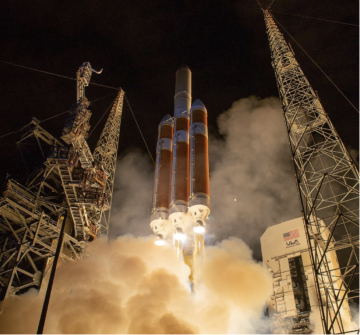
In the very early and still dark hours on August 12, 2018, NASA launched the Parker Solar Probe from the coast of eastern Florida. A Delta rocket lit up the sky with fire as the probe slowly lifted off its launch pad. It gained speed quickly and within a couple of minutes was just a bright light miles above the earth, looking much like the sun for where it was headed. After about six minutes, it was traveling over 14,000 miles per hour and was out of sight. Within three years of its seven-year mission, the probe has broken all speed records of a man-made object, traveling at 330,000 mph this year. Ultimately the craft will reach speeds of 430,000 miles per hour.
Watching the launch live at Cape Canaveral was 91-year-old Eugene Parker, for whom the probe was named. In the video of the launch, Parker looks very much the professor he is, wearing a tweed coat, glasses, and a lanyard around his neck, presumably identifying him for entry into the viewing area. As the rocket launches, Parker’s mouth is agape and he appears to be in awe of the explosive force of the Delta rocket.
A little over a month ago, on December 14, 2021, NASA announced that the probe had flown into the sun’s outer atmosphere, known as its corona, and effectively touched the sun. The event actually had happened on April 28, 2021, some seven months before, but it took the scientists those months to analyze the data and realize what had happened.

That 14th day in December last year when NASA announced that the Parker Probe had entered the sun’s atmosphere should have been a day of vast celebration and remembrance. For in some ways it was just as great an accomplishment as landing a man on the moon.
But touching the sun with a spacecraft went largely unnoticed by Americans. Here’s something that far more Americans celebrated or even knew occurred on December 14, 2021: Steph Curry made his 2,974th three-point shot, breaking the all-time record for three-point shots held by Ray Allen. In this awkward age of American culture, I don’t know how to measure the value of something to our society other than by YouTube views, Facebook likes, or retweets. Curry’s record-setting three-pointer got roughly five times the YouTube views as the launch of the Parker Probe. Curry is an amazing athlete but maybe all the mathletes at NASA should have gotten a little more hero worship that same day when their spacecraft ripped through the cosmos some 90 million miles distance from Madison Square Garden.
The Parker Probe mission was conceived of some sixty years ago, based on Parker’s theories about the sun’s makeup and behavior and some unanswered questions. As a young physicist, Parker was credited with discovering and explaining solar winds. Solar winds are the giant emissions of electromagnetic plasma and gasses that the sun sends outward from its corona. The earth is constantly hit with solar winds and without our own magnetic field, the winds would wipe us out. When the solar winds are particularly strong, they warp the earth’s magnetic field and sometimes cause major blackouts.

In 1989, a huge solar wind, described by NASA as having “the power of thousands of nuclear bombs,” knocked out the entire power grid of the Canadian province of Quebec. It also caused problems in hundreds of power grids across the United States, threw various satellites into disarray, and so intensified the northern lights that the effect could be seen in Cuba. While some of the physics of solar winds are understood by scientists, the Parker Probe is meant to broaden that understanding with real data from the sun’s corona.
Another lingering question that Parker raised decades ago and is still at issue is why the sun’s corona is hotter than its surface—several hundred times hotter. The surface of the sun is only about 11,000 degrees Fahrenheit while the corona is close to two million degrees Fahrenheit. Parker has proposed that nanoflares at the coronal surface explain the weird anomaly. The probe’s journey into the corona may help answer these questions and more.
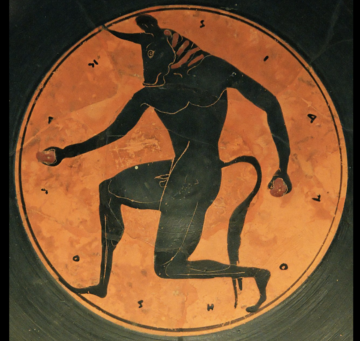
We have had a complicated relationship with the sun for thousands of years. In Greek mythology there was a great craftsman named Daedalus famed for his skills as an architect and builder. King Minos of Crete, enraged by his wife’s infidelity, asked Daedalus to build a labyrinth to imprison her love child. The love child, the fruit of her intimacy with a bull, was a minotaur–part bull and part man. The minotaur was put in the labyrinth but when Daedalus did things to offend the king, he and his son Icarus were jailed in the labyrinth too.
The only way Daedalus could see his way out of the labyrinth was by building a set of wax-and-feather wings for him and his son. When he finished the wings, and before their escape from the labyrinth, he told Icarus not to fly too close to the sun or the wax would melt and the wings would fail. We know what happened, Icarus didn’t listen to his father, the wings melted, and he fell to his death into a sea now named in his memory. The myth has served as a warning to countless men and women with overweening ambitions. A man or woman too desperate to get ahead is considered to have an Icarus Complex.
The late naturalist E.O. Wilson put it well when he wrote, “We have Paleolithic emotions, medieval institutions and godlike technology.” If you take even a layman’s understanding of the science, technology and imagination behind the success of the Parker Probe, Daedalus would be proud of what they accomplished, godlike, at NASA.
One of the technical difficulties of flying a probe so close to the sun is the heating and cooling issue. The probe will encounter temperatures in the millions of degrees Fahrenheit but due to the low density of the sun’s atmosphere, the heat will only be about 2,500 degrees Fahrenheit (see heat versus temperature). Nevertheless, protecting the probe’s instruments from that sort of heat requires a high-tech carbon shield. The heat shield on the Parker Probe is only about eight feet in diameter and has a carbon-carbon shell sandwiching a foam core that is 97% air. The carbon-carbon material is similar to the materials used for expensive tennis racquets and golf clubs.
As the probe is scheduled for a seven-year mission, obviously it needs a power source to keep its instruments running. Solar power is the obvious answer to that problem but facing solar panels directly at the sun when so close would mean their immediate destruction. The panels on the probe will face more than 600 times the irradiance as is seen on earth (650 kilowatts per square meter versus 1 kilowatt per square meter). To collect solar power without cooking the solar panels, the engineers placed the panels at a shallow angle to the sun. As the probe gets closer to the sun, only the tips of the panels are irradiated while the main body of the panels sits in the shadow of the heat shield.
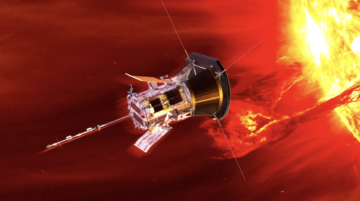
Even with the low angle, the engineers realized that the panels would overheat without a cooling system. So they built a water cooling system similar to that in your car. The cooling system uses just water (no antifreeze) and circulates between the solar panels and four radiators tucked behind the heat shield. The water-cooled system ensures that the panels will never climb above 250 degrees Fahrenheit.
But overheating wasn’t the only issue the engineers had to face. Early in the mission, far from the sun, and in the shadow of Venus, there was real danger that the water would freeze. So the engineers pre-heated the water to about 120 degrees while still on earth. The first few weeks of the probe’s journey, the water was kept in a reservoir. The engineers also manipulated the angle of the probe to expose the radiators to the sun to warm them in those first weeks. Finally, as the probe approached the sun and the danger of freezing was behind, the water was released into the system to circulate as a coolant on the panels.
With the need to first keep the water from freezing and then to deploy the water to cool the solar panels millions of miles from earth, NASA may have faced the most complicated HVAC problem in history. When I ask my plumber various questions about my own HVAC system, which is considerably less sophisticated than the one on the Parker Probe, I sometimes envision that scene from the Paper Chase and him saying, “Here’s a dime. Call your mother and tell her you’ll never be a rocket scientist.”
For most of human existence, it was assumed that the sun revolved around the earth. The Greco-Egyptian astronomer Ptolemy solidified this belief with a treatise titled Almagest. Ptolemy wrote The Almagest–roughly translated from Arabic to mean The Majesty—in the second century, and through mathematics, historical data, and his own observations, did a good job of convincing himself and the world that the earth was the center of the universe. His theory lasted a good 1,400 years until the Polish-born Nicolaus Copernicus came up with a better theory.

In his treatise De Revolutionibus Orbium Coelestium (On the Revolutions of the Celestial Spheres), by postulating that the earth and all the visible planets revolve around the sun, Copernicus solved some major inconsistencies in Ptolemy’s treatise. From the perspective of earth, it always appeared that the outer planets would reverse course in their travels—a retrograde orbit. Ptolemy theorized that each planet had two orbits: the larger orbit around the earth and much smaller orbits independent of the sun called epicycles. With the sun at the center of the solar system, as described by Copernicus, the apparent retrogrades could easily be understood as single orbits around the sun, just at different speeds.
De Revolutionibus had an initial printing of only 400 copies yet failed to sell out completely. There is a common belief that the clergy rejected Copernicus’s theory because, in the words of Carl Sagan, it dethroned man as the center of the universe. But the Canadian scholar Dennis Danielson disputes that idea and suggests that to many in the clergy, Copernicus’s theory elevated man’s position in the cosmos to many philosophers of the day. For the center of the universe was considered to be the basement of things where the coarse elements gathered. To be elevated from that position by the new heliocentric theory meant that the earth was dancing in the firmament with the other planets.
It’s only decades later that members of the clergy and some philosophers decided that Copernicus dethroned man’s position in the universe with this theory. Danielson goes so far as to say that the idea of treating the heliocentric theory as a cosmic dethroning was a self-congratulatory act to signal modesty and enlightenment.
As a person who will never be a rocket scientist, to me one of the most marvelous aspects of the Parker mission is NASA’s use of the planet Venus to decelerate the probe and change its orbit so it can get closer to the sun. Using a planet to accelerate or decelerate a rocket is what’s known in the trade as a gravity assist or swing-by. The concept is pure genius. Depending on the distance, approach angle, and velocity, engineers have been using gravity assists since 1959 when the Soviets used it on their space probe, Luna 3, which photographed the far side of the moon. To parlay photos of the moon back to earth, the Soviets needed the Luna 3 to establish an orbit that would take it around the moon and then back around earth. By entering the moon’s gravitational field from south to north, the Soviets bent the orbit of the craft and successfully sent photos of the far side of the moon back to their control station.
Perhaps the most interesting thing about the gravity assist idea is that it was conceived in the 1920s when people were still driving Model A cars, by a Russian named Yuri Kondratyuk. If there were ever a competition for “the most interesting man in the world” like those Dos Equis Beer commercials, Kondratyuk would make a strong contender. He fought in both world wars, unfortunately on the side of the Czar in the first, and more unfortunately still, was killed in the second world war.

He only lived to be 44, but what a 44 years that was. He had to change his name from Aleksandr Ignatyevich Shargei to Yuri Kondratyuk after the first war to avoid the wrath of the revolutionaries. In his thirties he was sentenced to three years of gulag imprisonment for what was actually genius design. The Soviet government asked him to design a huge granary and because there was a shortage of metal, Kondratyuk designed the entire structure to be built without a single nail. The structure was built and stood for decades until it was destroyed by a fire in the 1980s. But in their infinite wisdom, the Stalinist police decided that Kondratyuk had designed the granary without nails so it would collapse and embarrass the government. They convicted him of anti-soviet activity.
Despite all the turmoil in his life he really invented modern spaceflight. In 1925 in a self-published book titled Conquest of Interplanetary Space Kondratyuk proposed both gravitational assists and modular space crafts—the idea of leaving one vehicle in lunar orbit while a smaller vehicle landed on the moon, later to join the orbiting vehicle. Mind you, when Kondratyuk proposed using planetary gravitational fields to change orbits of spacecraft and proposed lunar orbit rendezvous vehicles, the most advanced flying machines were biplanes that traveled less than 300 mph.
Americans used Kondratyuk’s ideas on the successful Apollo missions to the moon forty years later. And while his legacy in the Soviet Union for many years was largely undervalued, when Neil Armstrong visited the home where Kondratyuk lived in the Siberian town of Novosibirsk, he gathered a handful of soil as a memento to recognize the early pioneer’s contribution to space exploration and encouraged the Soviet Union to better honor him. Kondratyuk has since been put on a stamp, had parts of the moon named after him, as well as a minor planet.
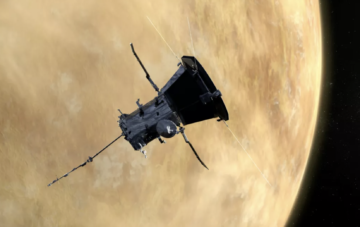
With the Parker Probe, NASA is using Kondrtayuk’s gravity assist concept to slow the craft and bring it closer and closer to the sun. Using the gravitational force of Venus and exquisite timing as Venus makes its own orbits, the Parker Probe is making tighter and tighter elliptical orbits around the sun. The last Venus swing-by was October 16, 2021, when the craft flew within about 2,400 miles of Venus. But to perfect the swing-by, the probe made tiny adjustments in its speed of about 1/3 mile per hour on September 29, 2021. The swing-by in October reduced the probe’s speed by about 6,000 mph. There have already been five Venus swing-bys and two more are scheduled.
Sitting here in the early morning writing this, I was trying to think of a good analogy for a gravity assist. I shouldn’t admit this, but the first thing that came to mind was one of those grotesquely huge fake wrestlers, such as “The Undertaker,” bouncing off the arena ropes to increase their power as they flatten someone like “Latino Heat.” Further evidence that I won’t be called up for an orbital consult by NASA anytime soon.
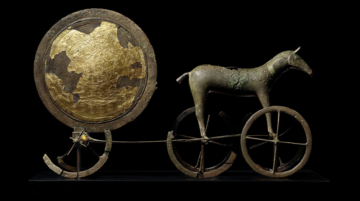
Since Neolithic times, the sun has been worshipped by peoples all over the earth. For the ancient Egyptians, it was Ra, god of the sun and king of the gods. Since the bronze age, Nordic cultures worshipped the sun as is evidenced by The Trundholm sun chariot, discovered in Denmark and estimated to have been made in 1400 BC. For the Buddhists, the god of good health was Sūryaprabha, from the Sanskrit for sunlight. In the Incan empire, the sun god Inti was considered an ancestor of the Incan people and is worshipped to this day in an annual festival in June in Peru called Inti Raymi. The Argentine flag, two broad stripes of blue surrounding a broad white stripe features a large sun in the middle, called The Sun of May, and said to represent the sun god Inti. That the Argentines haven’t replaced Inti with the soccer greats Maradona or Messi shows their continued dedication to the sun.
Most of us think of a year’s time in terms of seasons, the progress from dark days to summer days and back to the dark days. The earth’s tilted axis, known by scientists as its obliquity, gives us the seasons and also, to some of us, seasonal affective disorder. Obliquity also refers to moral failings and dishonesty and comes from the Latin obliquus for slanting, sidelong, and indirect. But we forget that in a year’s time we rip through space nearly 584 million miles as we circle the sun. That means my mother, who is 91, has traveled close to 53 billion miles over her lifetime, not including trips to the post office and vacations. Parker, born a few years earlier has traveled close to 55 billion miles around the sun.
Our most existential problem today is of course facing the sun and mitigating its heat in an atmosphere we’ve so adulterated. The paradox is that solving the problem will come largely from the sun itself as we turn to solar and wind energy on our desperate path to stop smoking up the heavens.

As I write this, the Parker Probe is near its aphelion—the farthest distance from the sun on its 11th orbit of the sun. It’s traveling at over 300,000 miles per hour. In late February it will be at a new perihelion ever closer to the star. In the summer of 2025, the probe will complete its 24th orbit of the sun and we will likely lose contact with it shortly thereafter–in the words of A.E. Houseman, “Past touch and sight and sound, Not further to be found.” The fantastic trajectory of our science and engineering from biplanes only a hundred years ago to this craft traveling hundreds of thousands of miles per hour, millions of miles from earth is some cause for hope. If our Paleolithic emotions and medieval institutions can embrace the better parts of our godlike technology—and fast—we may save ourselves from the sun as we embrace it.
